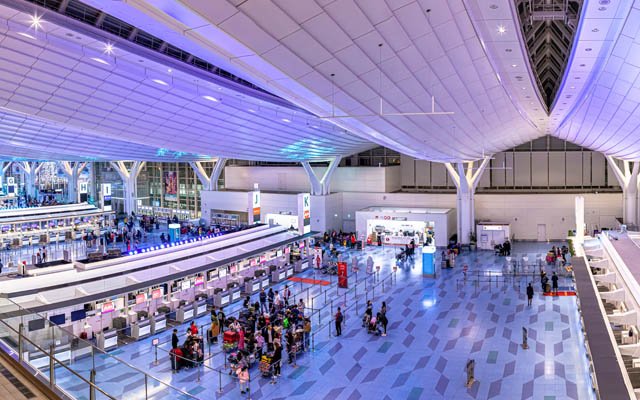Travel Trends
From Bleisure to AI-Powered Journeys: The New Era of Chinese Travel Trends

China’s travel market is undergoing a transformation that reflects the country’s evolving social dynamics, technological adoption, and global business ambitions.
Industry data and insights from Tourism Economics, Trip.com Group, and ITB China’s Buyer Circle reveal a market that is no longer defined by a single type of traveler. Instead, it is rapidly fragmenting into diverse segments driven by generational preferences, lifestyle shifts, and new economic opportunities.
For international destinations and travel service providers, these shifts present both challenges and lucrative opportunities. From the rise of “bleisure” travel to the acceleration of AI-driven services and the growing participation of senior travelers, the Chinese travel ecosystem is signaling a new era where personalization, value creation, and cultural immersion take center stage.
Outbound Travel: Younger Explorers and Active Seniors Take the Lead
Trip.com Group data shows that travelers born in the 1980s and 1990s continue to dominate China’s outbound travel, representing 67% of this segment in 2024. These digital-savvy adventurers are shaping demand with a preference for independent itineraries, lifestyle-driven trips, and non-traditional destinations. At the same time, a powerful wave of senior travelers is emerging. By the end of 2025, more than 100 million “active seniors” are expected to participate in outbound travel, with the market projected to exceed RMB 1 trillion (USD 140 billion).
This dual growth signals a potential divergence in outbound travel behavior. While younger travelers are drawn to flexible, tech-enabled, and immersive experiences, senior travelers prioritize comfort, accessibility, and culturally enriching journeys. Travel brands will need to design products that cater to both ends of this demographic spectrum, balancing innovation with inclusivity.
Personalization and Non-Traditional Destinations Drive Growth
Chinese travelers are moving beyond checklist-style sightseeing. According to the ITB China Buyer Survey, 82% of respondents already offer customized destination programs to meet demand for emotionally resonant and culturally grounded travel. However, structured group travel still maintains a foothold, with 48% of travel agents selling seat-in or small-group destination tours.
This evolution is prompting the development of hybrid travel models that blend independence with logistical support. High-spending travelers are particularly willing to pay a premium for unique, non-traditional experiences that promise authenticity without sacrificing comfort. The challenge for travel providers lies in scaling these offerings while maintaining the quality and cultural depth that discerning travelers expect.
Bleisure and MICE: Business Travel Redefined
Chinese enterprises expanding abroad are fueling growth in Meetings, Incentives, Conferences, and Exhibitions (MICE) tourism. According to the ITB China Buyer Survey, 83% of respondents identified “business + leisure” (bleisure) as a key growth opportunity. Corporate clients increasingly seek travel solutions that combine productivity with relaxation, emphasizing employee well-being, engagement, and brand storytelling.
This shift is transforming MICE tourism from a cost-focused activity into a value-driven growth engine. Destinations that can offer flexible leisure extensions, authentic cultural experiences, and excellent connectivity will stand out in the competitive global market for corporate travel.
Technology and Policy Fuel High-Quality Travel Growth
AI adoption is accelerating across China’s travel industry. More than half of surveyed ITB China Buyer Circle members report using AI tools for product recommendations, customer service, and market analysis. This trend is reshaping the travel value chain, enabling greater personalization, dynamic pricing, and automated services.
At the same time, supportive policies—ranging from visa facilitation to digital payment expansion—are reducing barriers to both inbound and outbound travel. As air connectivity continues to rebuild, travel companies that combine technology with human-centered service are likely to capture the next phase of market growth.
Inbound Tourism: China’s Global Appeal Strengthens
China is also becoming more attractive to international travelers. Tourism Economics projects that the country’s share of global inbound overnights will continue to grow as its cities deepen their product offerings and service readiness. Demand for free independent travel (FIT) is rising, social media increasingly shapes trip planning, and non-traditional destinations across China are attracting more attention from global tourists.
For inbound providers, adapting to this shift requires more than traditional landmark promotion. International travelers now seek immersive, lifestyle-led experiences that reflect local culture and authenticity. As this trend accelerates, destinations that innovate in experience design and market to emerging source regions will gain a competitive edge.
China’s travel evolution is no longer just about volume. It is about value, personalization, and strategic alignment with new consumer behaviors. For global travel stakeholders, the message is clear: the next wave of opportunity lies in embracing the diversity, technology, and cultural depth shaping China’s new travel era.
Travel Trends
Japan sees surge in summer outbound travel as demand climbs

Japan’s travel trade is seeing increased sales of outbound trips this summer, with more consumers choosing to travel overseas compared to last year.
JTB Corp., the country’s largest travel agent, expects some 2.4 million people to travel abroad for at least one night between July 15 and August 31, equating to an increase of 21 per cent over the same period last year. Average traveller spend is estimated at 289,000 yen (US$1,961), six per cent more than in summer 2024.
HIS Group, meanwhile, reports an 8.2 per cent rise in bookings year-on-year for overseas trips between July 19 and August 31, with an average cost increase per booking of seven per cent.
The trend is being driven by increased flight capacity, a stronger yen and larger-than-usual summer bonuses. Public and private sector campaigns to encourage overseas travel – such as gift certificates, discounted fares and subsidies for new passports – are also supporting outbound sales, according to agents.
Among this year’s summer destinations, Europe and South Korea are the most popular with JTB customers, each accounting for 17 per cent of bookings, followed by Taiwan and Southeast Asia at 14 per cent each. The company has also recorded a rise in bookings for Hawaii compared to the same period last year.
Similarly, HIS said Seoul, Taipei and Honolulu remain top choices for its clients this summer. However, strong growth has also been seen in emerging destinations such as Cairo, Shanghai and Barcelona.
Travel Trends
M2P Consulting is new BARIG business partner

FRANKFURT AM MAIN – With M2P Consulting the airline association BARIG (Board of Airline Representatives in Germany) welcomes a new business partner that has already supported numerous airlines, airports, railway and logistics companies, and other providers with its consulting services. M2P Consulting stands for innovation and customer focus in long-term partnerships and provides companies with customized, efficient solutions for transformation in the traffic, transport, and logistics sector.
“Air travel faces major challenges in both passenger and air cargo transport. It is therefore crucial for all stakeholders to actively address these challenges in order to set the course for the future and growth,” states BARIG Chairman and Executive Director Michael Hoppe. “M2P Consulting’s international expertise will provide valuable impetus for our members, particularly in the areas of automation and digitalization.”
“We have successfully completed over 500 projects for more than 100 customers from all over the world, also using cloud-based technical solutions that we develop in-house and tailor according to specific needs,” explains Christophe Mostert, Managing Partner at M2P Consulting. “Aviation is a key focus at M2P Consulting. We are happy to contribute our experience to the BARIG community.”
With a team of over 100 employees, M2P Consulting supports international clients from the aviation industry from its locations in Frankfurt am Main, Dubai, Los Angeles, and New York. Its range of services includes digitalization, process optimization, and efficiency improvement in particular. Especially for airlines, M2P Consulting develops strategies for network planning, pricing, and sales, among other things.
The article M2P Consulting is new BARIG business partner first appeared in TravelDailyNews International.
Travel Trends
A New Era for Sustainable and Immersive Tourism

The global tourism industry is undergoing a seismic shift, driven by a confluence of technological innovation, environmental consciousness, and a deepening appetite for culturally rich experiences. At the forefront of this transformation is Trip.com Group, whose 2025 Tourism Innovation Awards have spotlighted projects that redefine travel as a force for sustainability, creativity, and cultural preservation. These awards, which recognize 10 groundbreaking initiatives across Asia, the Middle East, and Europe, are not merely accolades—they are blueprints for the future of travel and a signal to investors of the sectors poised for exponential growth.
The Triple Pillars of Modern Tourism: Immersion, Sustainability, and Culture
The 2025 Tourism Innovation Awards underscore three dominant trends reshaping the industry: immersive technology, sustainable infrastructure, and cultural authenticity. Projects like Saudi Arabia’s Shebara Resort, with its floating sphere villas powered by solar energy and reversible construction, exemplify how luxury and environmental stewardship can coexist. Similarly, teamLab Borderless in Tokyo reimagines art as an interactive, boundary-defying experience, while London’s Harry Potter-themed King’s Cross Station merges nostalgia with cutting-edge storytelling. These projects are not isolated experiments but scalable models that align with a $11.39 trillion projected global sustainable tourism market by 2034.
Investors should note that these trends are not speculative. The awards’ evaluation framework—prioritizing innovation, sustainability, and scalability—has already demonstrated tangible impact. For instance, the top 10 winners saw an average 51% increase in destination orders and a 42% rise in search volume within three months of launch. This data underscores the growing consumer demand for travel that is both transformative and responsible.
Technology as the Catalyst: AI, VR/AR, and Hyper-Personalization
Trip.com Group’s strategic investments in AI-driven personalization are a linchpin of its innovation strategy. Tools like TripGenie and Trip.Best leverage artificial intelligence to curate real-time itineraries, while VR/AR platforms enable virtual previews of destinations, reducing the environmental footprint of exploratory travel. These technologies are not just enhancing user experience—they are redefining the economics of travel.
Consider the financial metrics: Trip.com’s AI-powered tools drove a 200% surge in usage in 2024, with 58% of travelers already relying on AI for recommendations. The company’s R&D spending increased by 13% year-over-year in Q1 2025, reflecting a commitment to scalable technologies that reduce per-user acquisition costs. For investors, this signals a shift toward a travel ecosystem where data-driven personalization and immersive tech are not optional but essential.
Sustainable Tourism: From Niche to Mainstream
The awards also highlight a critical pivot toward sustainability. Shebara Resort’s energy recycling systems and DesertxAlUla’s art-nature fusion are emblematic of a broader industry trend: travelers now demand that their experiences align with their values. Trip.com’s carbon transparency tools, which quantify emissions across flights and car rentals, have already driven 100 million sustainable travel orders in 2024—a 34% year-over-year increase.
This shift is not just ethical; it is economic. The Asia-Pacific sustainable tourism market, growing at a 15% CAGR, is projected to reach $42 billion by 2030. Trip.com’s Country Retreat Programme, which expanded to 34 destinations in 2025, has created 40,000 indirect jobs and boosted local incomes by $5,500 per capita in regions like Bali and Costa Rica. Such initiatives align with the UN’s Sustainable Development Goals while generating long-term value for stakeholders.
Cultural Immersion: The New Travel Checklist
Cultural heritage is another cornerstone of the 2025 awards. Projects like Egypt’s Grand Egyptian Museum, with its 100,000 artifacts and holographic technology, and Japan’s Nintendo Museum, which blends gaming history with interactive exhibits, cater to a generation of travelers seeking authenticity. These experiences are not passive—they are participatory, fostering deeper connections between visitors and destinations.
For investors, the cultural tourism sector offers a dual opportunity: preserving heritage while monetizing it. The Grand Egyptian Museum, for example, has become a major attraction within months of opening, demonstrating the commercial viability of culturally rich projects. As 70% of Gen Z and Millennials prioritize unique, unexplored experiences, the demand for such offerings will only intensify.
Investment Opportunities: Where to Allocate Capital
The convergence of these trends creates a roadmap for investors. Key areas to consider include:
1. AI-Driven Travel Platforms: Companies developing hyper-personalized itineraries and real-time language tools.
2. Sustainable Infrastructure: Firms specializing in eco-friendly construction, renewable energy integration, and carbon offset programs.
3. Immersive Tech Providers: Developers of VR/AR solutions for virtual travel previews and interactive cultural experiences.
4. Cultural Heritage Projects: Partnerships with destinations that blend historical preservation with modern innovation.
Trip.com Group’s $100 million Tourism Innovation Fund and its 31% EBITDA margin in Q1 2025 position it as a prime beneficiary of these trends. However, investors should also look beyond the platform to niche players in AI, green energy, and cultural tourism. For example, the rise of “last-chance tourism” to endangered destinations could drive demand for conservation-focused travel startups.
Conclusion: The Future of Travel is Here
Trip.com Group’s 2025 Tourism Innovation Awards are more than a celebration—they are a harbinger of the industry’s next phase. As immersive tech, sustainability, and cultural authenticity converge, the travel sector is evolving from a commodity-driven model to a value-driven one. For investors, this means opportunities in sectors that align with both planetary and consumer priorities. The winners of these awards are not just redefining destinations; they are redefining the very purpose of travel.
The time to act is now. With the Asia-Pacific sustainable tourism market growing at 15% annually and AI adoption in travel set to accelerate, the next decade will belong to those who invest in the future of experiential travel.
-

 Brand Stories2 weeks ago
Brand Stories2 weeks agoBloom Hotels: A Modern Vision of Hospitality Redefining Travel
-

 Brand Stories2 weeks ago
Brand Stories2 weeks agoCheQin.ai sets a new standard for hotel booking with its AI capabilities: empowering travellers to bargain, choose the best, and book with clarity.
-

 Destinations & Things To Do2 weeks ago
Destinations & Things To Do2 weeks agoUntouched Destinations: Stunning Hidden Gems You Must Visit
-

 Destinations & Things To Do2 weeks ago
Destinations & Things To Do2 weeks agoThis Hidden Beach in India Glows at Night-But Only in One Secret Season
-

 AI in Travel2 weeks ago
AI in Travel2 weeks agoAI Travel Revolution: Must-Have Guide to the Best Experience
-

 Brand Stories1 month ago
Brand Stories1 month agoVoice AI Startup ElevenLabs Plans to Add Hubs Around the World
-

 Brand Stories4 weeks ago
Brand Stories4 weeks agoHow Elon Musk’s rogue Grok chatbot became a cautionary AI tale
-

 Brand Stories2 weeks ago
Brand Stories2 weeks agoContactless Hospitality: Why Remote Management Technology Is Key to Seamless Guest Experiences
-

 Asia Travel Pulse1 month ago
Asia Travel Pulse1 month agoLooking For Adventure In Asia? Here Are 7 Epic Destinations You Need To Experience At Least Once – Zee News
-

 AI in Travel1 month ago
AI in Travel1 month ago‘Will AI take my job?’ A trip to a Beijing fortune-telling bar to see what lies ahead | China

You must be logged in to post a comment Login